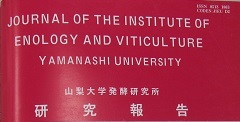

 |
山梨大学醗酵研究所 研究報告[1254年-1997年] JOURNAL OF THE INSTITUTE OF ENOLOGY AND VITICULTURE |
| vol.25 (1990) |
|
「ワイン酵母W3の低胞子生存率」
Low Spore Viability in Wine Yeast Strain W3 山崎豊彦・野々村英夫 TOYOHIKO YAMAZAKI and HIDEO NONOMURA (Department of Fermentation Technology, Faculty of Engineering, Yamanashi University) pp.1-4.[PDF] |
|
2倍体と考えられたワイン酵母W3における胞子のう(四分子)の73%は,2/4の発芽形式を示し,その生存率は,二倍体OC2(100%)にくらべ,かなり低い値(40%)であった。また,死滅する胞子は,2-3細胞期以後の増殖が停止した。また,一倍体研究室株との融合株とその子孫(単胞子株)の胞子生存率には,大きな変動(74%→8~23%)が観察された。これらの結果は,ワイン酵母W3に劣性致死因子の存在を想定することにより説明ができた。 Wine yeast strain W3 which was determined as a diploid strain produced asci with no more than two viable spores in 40 asci dissected by micromanipulator.From this, spore viability of the strain W3 was 40%,less than that (100%) of strain OC2 used as a standard diploid strain.Two spores in an ascus of the strain W3 germinated with a few cells before they definitely ceased growing and died. The fused hybrids obtained between the strain W3 and a haploid laboratory strain yielded spores with relatively high viability (73–75%). In contrast, some progenies (spore clones) derived from the hybrids had low spore viability (8~23%). These results relating to spore viability in the strain W3 could be accounted for by assuming the presence of recessive lethal gene (let) in the strain. |
|
「ワイン中のインベルターゼ活性とその性質」 Invertase Activity and its Properties Wines 中西載慶 ・横塚 弘毅 KOTOYOSHI NAKANISHI and KOKI YOKOTSUKA (Laboratory of Wine Chemistry, The Institute of Enology and ViticultureYamanashi University) pp. 5-14[PDF] |
|
ワイン製造過程 におけるブドウインベルターゼの活性推移,市販ワイン中のインベルターゼ活性, およびワイン中のインベルターゼの精製と性質等について検討し, 以下の結果を得た。 1.白ワインではビン熟成1年後のワインにおいても圧搾果汁中の活性の32-⊥68%の活性が残存していたが,赤ワインにおける活性は, いずれも5%以下であった。また,赤ワインにおける活性の低下は,発酵中および熟成中で顕著であった。 2.市販の外国産白ワインにおいては,試験した18サンプル中,9サンプルにインベルターゼ活性が検出されたが日本産白ワインでは17サンプル中,わずか1サンプルに弱い活性が認められたのみであった赤ワインにおいては,外国産,日本産とも活性は極めて微弱であった。 3.ワイン中のインベルターゼ活性の測定は,原料ブドウの品質やワインの製造法を推察するための1つの指標として,役立つ可能性のあることが示唆された。 4.セミヨン,シルバーナ,シャルドネ,およびリースリングワインよりインベルターゼを精製し,それらの分子量,アミノ酸組成,および若干の酵素的性質について調べた結果,いずれも極めてよく類似していることがわかった。 The levels of invertase activity in juice,must,and wine were examined during vinification and aging processe.There maining activity levels in white wines were significantly higher than those in red wines in red wines,alowerlng of the level in the、enzyme activity was mainly observed during the process of the fermentation and aging.Invertase activity was also detected in many commercial imported white wines.On the other hand,invertases from Semillon,Sylvaner,Chardonnay,and Riesling wines were purified to homogeneity on polyacrylamide slab gel electrophoresis.The invertas the four sources showed similar enzymatic properties.Ⅰnaddition,these invertases had very similar molecular weights and amino acid composition. |
|
Determination of sulfur dioxide using a microbial sensor HIROSHI KUROSAWA, DADANG ROSADI, KAZUO NAKAMURA,and YOSHIFUMI AMANO (Department of Applied Chemistry and Biotechnology, Faculty of Engineering, Yamanashi University) pp.15-20[PDF] |
| The concentration of free sulfur dioxide in wine and dried fruits was determined using a microbial sensor method and the modified Rankine's method.The values obtained by the sensor method were more accurate than those by the modified Rankine's method.Pigments in the red wine did not disturb the measurements with the sensor.The sensor was also possible to determine the sulfur dioxide in extracts of dried fruits accurately even though the extracts contained 7 % of sugar. Moreover,the microbial sensor method was more profitable economically from the point of view of reducing the time and the materials for analysis especially when the measurement of many samples were performed. |
|
「カベルネ・ソービニヨンとマスカット・ベリーAブドウからのブラッシュ・ワインの製造」 Production of Blush Wines from Muscat Bailey A and Cabernet Sauvignon Grapes 横塚弘毅・村田純・蛇原哲也・ 松土俊秀・中西載慶 KOKI YOKOTSUKA, JUN MURATA, TETSUYA EBIHARA TOSHIHIDE MATSUDO and KOTOYOSHI NAKANISHI (The Institute of Enology and Viticulture, Yamanashi University) pp.21-26[PDF] |
|
マスカット・ベリーA及びカベルネ・ソービニヨン・ブドウを破砕し,室温で20分間,スキン・コンタクトした。その後,0.2, 1.0あるいは2.0kg/cmの圧搾圧力で搾汁し,それぞれのブドウより3種類のマスを得た。これらのマストを用いて,通常の白ワインの醸造法に従って,ブラッシュ・ワインを製造した。マストとワインの収量,pH,酸度,糖度,全フェノール,タンニン,総窒素,及び種々の色素成分,並びにワインの比重アルコール,エキス,還元糖,灰分,亜硫酸を分析した。どちらのブドウの場合でも,スキン・コンタクト後の破砕ブドウを圧搾する時の圧搾圧力の違いによって,マストあるいはワイン中の上記の成分含量に大きな差異は認められなかった。これは,20分間のスキン・コンタクトの間に,多量の成分が果皮よりマストへ抽出され,圧搾圧力 の効果が顕著にでなかったためと思われる。これらのブラッシュ・ワインの成分組成と,同じロットのブドウから通常の方法で製造された赤ワインの成分組成とを比較した結果ブラッシュワインの方がpHがかなり低く,また総フェノールと総窒素量も非常に低い値となった。一方,ブラッシュ・ワイン のColor DensityとWine Colorは,赤ワインのそれらの60~90%であった。その他の成分に関しては,赤ワインとブラッシュ・ワインの間には大きな差は認められなかった。 Muscat Bailey A and Cabernet Sauvignon grapes were destemmed, crushed, and kept in contact with the skins for 20 min at room temperature before pressing.Three fractions of must from each grape variety were obtained by pressing at 0.2, 1.0, or 2.0 kg/cm" pressure.The musts were used to make blush wines using the conventional method for white wine-making. The musts and wines were analyzed for pH, total acidity, sugar, total phenol, tannin, total nitrogen, color, and pigments. Furthermore, the wines were analyzed for specific gravity, alcohol, extract, volatile acid, ash, and sulfur dioxide. There was no significant correlation between the must or wine components and the pressing pressures in both wines. This is because, since the pressing was done after the skin contact with the crushed grapes, a lot of the skin components were already extracted into musts. In comparison with red table wines made from the same grape lots, the pH as well as the total phenol and nitrogen contents of the blush wines were lower. Ahe color density and wine color of the blush wines were 60 to 90% of those of the red wines.However,there was no significant difference in other components between the red and blush wines. |
|
「交雑新品種・赤ワイン用ぶどう"ヤマ ・メルロー''の品種特性について」 Characterization of Hybrid NewRed-Wine Grape Cultivar "YamaMerlot"(Japanese wild-grape × Merlot) 山川祥秀 ・守屋正憲・穴水秀教 YOSHIHIDE YAMAKAWA,MASANORI MORIYA and HIDENORI ANAMIZU (The Experimental Vineyard,Institute of Enology and Viticulture, Yamanashi University) pp.27-36[PDF] |
|
交雑新 品種 ・赤ワイン用ぶどう``ヤマ ・メルロー” は以下の性質を持っていることにより選抜された。 1.裂果しないこと。 2.晩腐病,ベト病および灰色カビ病に耐性を持つこと。 3.栽培性が日本の気候に適していること。 4.結実量が多いこと。 5.ワインの品質が良く,特徴があること。 当品種は, 日本の野生ぶどうである"山ブトウ'を母親とし,"メルロー''を父親としている。 成業は五角形で裂片数は 3片,緑色で295cm!の大型葉である。葉身先端部の尖り程度は600以下の鋭に属する。葉柄裂刻はU字形で開いている。葉柄の色は濃紅を呈する。葉裏葉脈間の毛じは中程度である。 呆房は有岐円錐型,大きさは220gの中,粒着は粗着である。果粒は小さく1.4g,円形,果皮色は完熟期には紫黒を呈し,果粉は中程度である。果汁糖度は20%以上,果汁酸度は0.90%以下である。 生態として,発芽期は早く4月中旬,開花期も早く5月下旬,完熟期は中期の 9月上・中旬である。 裂果せず,結実量は10アール当たり2トン以上の多収,晩腐病,ベト病,灰色カビ病に耐性を持つ。 The hybrid red-wine grape cultivar H Yama Merlot H was selected and recommended due to the following Characteristics: (1) no crackling of berry, (2) resistance to ripe-rot, downy mildew,and gray mold, (3) suitability for cultivation under the weather conditions prevailing in Japan, (4) high productivity, (5) high quality wine with typical aroma and taste. Origin : Japanese orlglnal wild grape variety H Yamabudou"(Vitis coignetiae)X the superior red wine grape Variety Bordeaux region"Merlot"(Vitis Vinifera). Description : Mature Leaf: pentagonal shape, large (295cm2), three lobes, flat, green, shape of leaf tlp sharpe less 60°, petiole sinus U-shaped,open,color of petiole dark red, density of prostate hairs between the lower side veins medium. Cluster and Berry:long conical shape, medium (220g),low berry density,berries small(1.4g),roundish-shaped,color of skin violet black at maturity,medium bloom,high sweetness of fresh juice(more than 20%),high acidity(less than 0.90%). Ecotype: early bud burst time (mid-April),early flowering time (late May),and medium maturing time (early or mild-September) at Kofu,no cracking of berry,high productivity (more than 2 ton/10a),resistance to ripe-rot,downy mildew and gray mold. |
The Institute of Enology and Viticulture, University of Yamanashi 所在地:〒400-0005 山梨県甲府市北新1丁目125 |
ホ-ムペ-ジに掲載の文章・記事・写真・図表などの無断転載を禁止します。